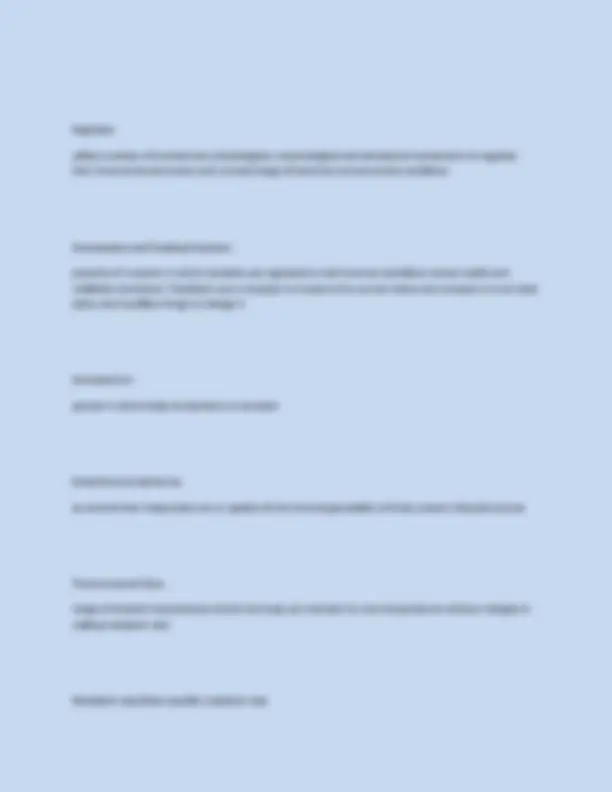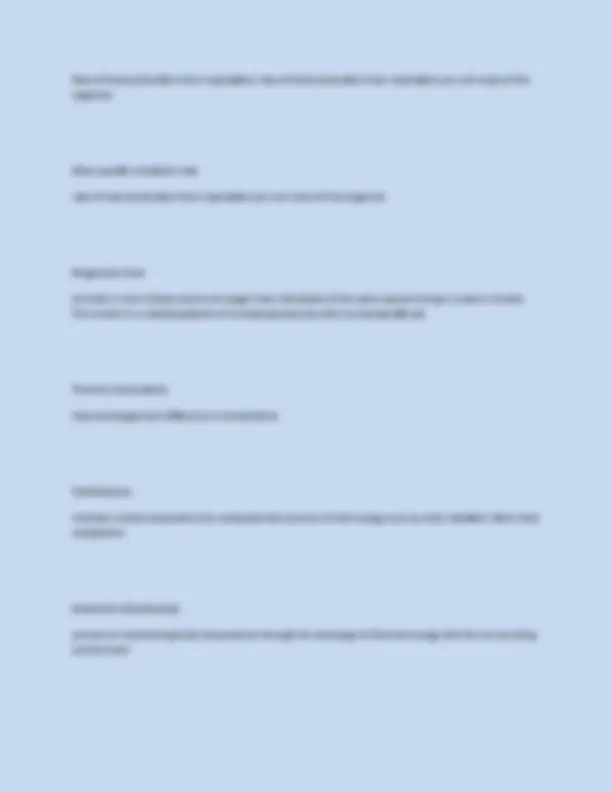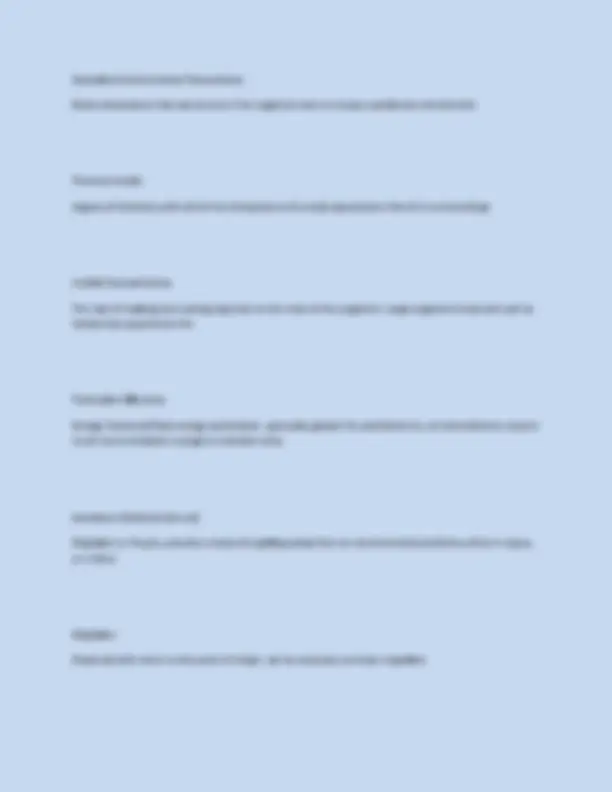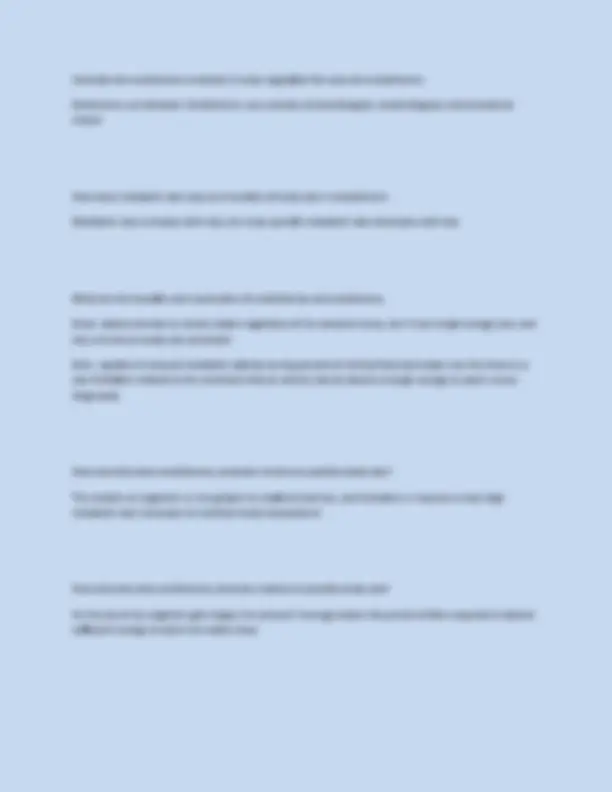

















Study with the several resources on Docsity

Earn points by helping other students or get them with a premium plan


Prepare for your exams
Study with the several resources on Docsity

Earn points to download
Earn points by helping other students or get them with a premium plan
Community
Ask the community for help and clear up your study doubts
Discover the best universities in your country according to Docsity users
Free resources
Download our free guides on studying techniques, anxiety management strategies, and thesis advice from Docsity tutors
UVA EVSC 3200 Test 1 Fundamentals Of Ecology Laboratory 2025 Solutions Questions With Completely Answers Rated A PLUS 100%
Typology: Exams
1 / 23

This page cannot be seen from the preview
Don't miss anything!
















Ecology
relationship of organisms and their environment
Ecosystem
A community of organisms that interact with the physical environment
Population
A group of individuals that belong to the same species and live in the same area
Community
all of the populations of different species that live and interact in an area
Adaptation
Any heritable behavioral, morphological, or physiological trait of an organism that has evolved over a period of time through natural selection (must maintain or increase fitness under given environmental conditions)
Environmental Tolerances
conditions beyond which an organism can no longer maintain a positive response
Gene
a stretch of DNA coding for a polypeptide chain (sequence of amino acids), where one or more polypeptides make up a protein
Allele
alternate forms of the same gene
Locus
Position occupied by a gene on a chromasome
Gene Expression
process of creating proteins from genetic code in dna
Genotype
Recessive
In the case in which one allele masks the expression of the other the allele that is masked
Homozygous
if the two copies of the gene (alleles) are the same
Heterozygous
if the two alleles at the locus are different
Norm of Reaction
Set of phenotypic characteristics expressed by a genotype in different environments
Phenotypic Plasticity
ability of a genotype to express different phenotypic characteristics under different environmental conditions
Acclimation
Reversible phenotypic changes in an individual organism in response to changing environment (stingray's environmental tolerance based on season)
Developmental Plasticity
differences in phenotypic traits for a specific genotype under different environmental conditions that occur during growth - largely irreversible
Natural Selection
differential success of individuals resulting in their interaction with their environment
Fitness
number of offspring produced that contribute to future generations
Three Types of Selection
stabilizing, directional, and disruptive
directional selection
Form of natural selection in which the distribution of phenotype is shifted to one extreme
stabilizing selection
the mean phenotype in the population exhibits the highest relative fitness and the original distribution of phenotype is shifted to the center
Constraints and Tradeoffs in evolution of adaptations
An adaptation that allows an organism to do one thing may prevent it from doing another (finches with beak size being limited on food source)
Adaptive Radiation
The evolutionary diversification of species or single ancestral lineage to various forms that are each adaptively specialized to specific environment/resource
Autotroph/Heterotroph
oAn organism that obtains food (carbon) w/out consuming other organisms. Utilize carbon dioxide as a source of carbon, using energy from the sun to convert carbon dioxide (and other inorganic compounds) into organic compounds (primary producers)
Heterotroph
An organism that obtains food (carbon) by eating other organisms or their by-products (secondary producers)
Photosynthesis/Assimilation
Incorporation of atmospheric carbon (co2) into organic compounds through the use of light energy (light
Photorespiration
rubisco catalyzes reaction to produce co2 and PGA
Stomatal conductance
gs - inverse of stomatal resistance - function of number and aperture of stomata
Transpiration
Loss of water from inside the leaf to the atmosphere through the stomata - Rate is VPD*gs
Vapor Pressure Deficit
Saturation VP - Actual VP
Relative Humidity
Actual VP/Saturation VP*
Water Potential
potential energy of water per unit volume. Quantifies the tendency of water to move from one area to another due to osmosis, gravity, mechanical pressure, or matrix effects like capillary action - to maintain a flow, atm<leaf<root<soil
What is the link between the light and dark reactions of photosynthesis
The light-independent reactions derive their name from the fact that they do not directly require the presence of sunlight. They are, however, dependent on the products of the light-dependent reactions and therefore ultimately depend on the essential resource of sunlight.
What is the role of rubisco and chlorophyll in the process of photosynthesis
Rubisco catalyzes the reaction to make 3-PGA- which then is converted to a sugar rich molecule - chlorophyll absorbs the light energy
What are the components of stomatal conductance, and which ones are under the active control of the plant?
Stomatal conductance is a function of the number of stomata per leaf surface area and aperture (the size of the stomatal openings) of the stomata - the plant can control the aperture of the stomata
Describe Photosynthesis as a diffusion process
A = (Ca-Ci)*gs)
based on concentration of carbon of atmosphere and inside plant
CO2 diffuses from areas of higher concentration (the air) to areas of lower concentration (the interior of the leaf). When the concentrations are equal, an equilibrium is achieved and there is no further net exchange
What is the relationship between temperature and relative humidity and vapor pressure deficit
as temp increases, relative humidity decreases and VPD increases
How is transpiration controlled by the external physical environment and by the plant
E=VPD*gs
Transpiration depends on the VPD - environment, and aperture of stomata - plant
How does stomatal conductance respond to changes in relative humidity
As relative humidity increases, the stomata opens more because less water will egress
What conditions must hold to maintain the flow of water through the soil-plant-atmosphere continuum
Watm<Wleaf<Wroot<Wsoil
How do patterns of carbon allocation influence net carbon uptake and plant growth?
More carbon allocated to production of new tissues will increase plant growth, which will increase respiration, but could increase gross photosynthesis if leaf area increases
Photosynthetically Active Radiation
The portion of the electromagnetic spectrum that photosynthetic organisms use is between 400 and 700 nanometers
Visible Spectrum of light (pretty much)
Plants can allocate more of a percentage to roots, and lower leaf area reduces transpiratory losses
Contrast characteristics of plant species adapted to mesic (wet) and xeric (dry)
1 - Leaf Morphology 2-Root:Shoot 3- Water Use Efficiency
1 - larger, thinner/smaller thicker
2 - decreased/increased
3 - decreased/increased
Differences among the C3/C4/CAM photosnythetic pathways
C3-This photosynthetic pathway involving the initial fixation of CO2 into the threecarbon PGAs is called the Calvin-Benson cycle, or C3 cycle, and plants employing it are known as C3 plants
C4- C4 plants and CAM plants, a modified form of photosynthesis has evolved that increases water-use efficiency in warmer and drier environments. The modification involves an additional step in the conversion (fixation) of CO2 into sugars.
plants possessing the C4 photosynthetic pathway have a leaf anatomy different from that of C3 plants (see Figure 6.3). C4 plants have two distinct types of photosynthetic cells: the mesophyll cells and the bundle sheath cells. The bundle sheath cells surround the veins or vascular bundles (Figure 6.14). C plants divide photosynthesis between the mesophyll and the bundle sheath cells.
CAM- The CAM pathway is similar to the C4 pathway in that CO2 initially reacts with PEP and is transformed into four-carbon compounds using the enzyme PEP carboxylase. The fourcarbon compounds are later converted back into CO2, which is transformed into glucose using the C3 cycle. Unlike C4 plants, however, in which these two steps are physically separate (in mesophyll and bundle sheath cells), both steps occur in the mesophyll cells but at separate times
General patterns of net photosnythesis response to leaf temperature
Bell curve, too hot and too cold decreased gross photosynthesis
Acclimation to season variations in temperature
What it sounds like I guess- know graph, different seasons have different optimal temperatures
Differences in temperature response of photosnythesis for C3 and C4 species
C3 plants have a lower optimum temperature, but also a lower maximum rate of photosynthesis
Plant net radiation balance (Longwave/Shortwave)
Net Radiation Absorbed = (shortwave solar reaching canopy+longwave ir emitted from atm and absorbed) - (shortwave solar reflected + longwave ir emitted by canopy to atm)
Normaly dominated by shortwave bc longwave has really high values but is relatively balanced
Dissipation of thermal energy (conduction/convection/evaporation)
Conduction and Convection is p x Cp(Tl-Tatm) x ga
Evaporation is lambda*E
p - density of air
Cp - specific heat of air
lambda - latent heat of vap for water
leaf nitrogen concentrations and maximum rates of net photosynthesis
positive correlation between leaf nitrogen and max photosynthesis
adaptations to low nutrient environments
Increased root:shoot%
Increased leaf longevity
Some legumes have rhizobium in their roots
what features of the physical environment limits a plants ability to dissapate heat via convection and evaporation
External temperature, wind speed, VPD, air density, Cp of air
Why is the maximum rate of photosnythesis positively correlated with leaf nitrogen concentration
Nitrogen is directly incorporated as an activator in the process of photosynthesis
Why is leaf longevity considered a possible adaptation for survival and growth in low nutrient environments
If a plant does not have to replace leaves as frequently, it will require less nutrients
What is the general tradeoff between the ability to tolerate low resource availability and the maximum rates of photosynthesis and growth under conditions of high resource availability
Generally, species adapted to tolerate low resource availability can't do as much when there are a lot of resources, and thus have lower rates of photosynthesis
Tradeoffs and Constraints
The set of characteristics that enable an organism to survive, grow and reproduce under one set of environmental conditions preclude it from doing equally well under different environmental conditions.
Adaptive Radiation
the evolutionary diversification of a species or single ancestral lineage into various forms that are each adaptively specialized to a particular environment
Allometry
Study of the relationship of body size to shape, anatomy, physiology, and behavior
Cope's Rule
evolution tends to increase body size over geological time in a lineage of populations
Conformer
unable to maintain internal conditions such as body fluid salinity, levels of tissue oxygen. Changes in external environmental conditions induce internal changes in the body that parallel the external conditions
Rate of heat production from respiration/ rate of heat production from respiration per unit mass of the organism
Mass specific metabolic rate
rate of heat production from respiration per unit mass of the organism
Bergmanns Rule
Animals in cold climate tend to be larger than individuals of the same species living in a warm climate. This results in a related gradient of increasing body size with increasing latitude.
Thermal Conductivity
Heat exchanged per difference in temperature
Poilkilotherm
maintain a body temperature by using external sources of heat energy such as solar radiation rather than metabolism
Ectotherm (Ectothermy)
process of maintaining body temperature through the exchange of thermal energy with the surrounding environment
Operative Environmental Temperature
Body temperature that would occur if an organism was to occupy a particular environment
Thermal Inertia
degree of slowness with which the temperature of a body approaches that of its surroundings
Inertial Homeothermy
The rate of heating and cooling depends on the mass of the organism. Large organisms heat and cool so slowly they experience this
Production Efficiency
Energy Produced/Total energy assimilated - generally greater for poikilotherms, as homeotherms require much more metabolic energy to maintain temp
Avoidance Methods (list em)
Migration or Torpor; provide a means for getting away from an environmental problems either in space, or in time
Migration
Dispersal with return to the point of origin, can be seasonal, ya know, migration